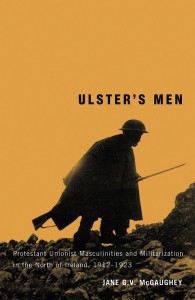ULSTER’S MEN: PROTESTANT UNIONIST MASCULINITIES AND MILITARIZATION IN THE NORTH OF IRELAND, 1912–1923
Published in Book Reviews, Issue 4 (July/August 2014), Reviews, Volume 22JANE G.V. McGAUGHEY
McGill–Queen’s University Press
$95 CAD
ISBN 9780773539723
Reviewed by
Jessica Meyer

In the past twenty years masculinity as a framework of historical analysis has moved from the margins of gender history in First World War studies to become a central element of discussion. Since the publication of Joanna Bourke’s Dismembering the male in 1996, there have been numerous publications in the field on aspects of masculine identity ranging from the impact of war on the male body to the changing definitions of heroism as a masculine ideal. Indeed, the panel on gender perspectives listed for a forthcoming conference on ‘Perspectives on the Great War’ (Queen Mary, University of London, 1–4 August 2014) contains a majority of papers on masculinity.
It is with this vigorous debate that Jane G.V. McGaughey’s book seeks to engage. Through the examination of public representations of ideal unionist masculinity from the Home Rule crisis to the end of the civil war, McGaughey argues that this identity came to be defined as Protestant, imperial and, above all, militarised. The case she makes for placing violence and militarisation at the heart of Protestant unionist masculinity in this period is a convincing one. From the adventures of gunrunning in 1914 through the glorification of the ‘blood debt’ incurred by the 36th (Ulster) Division at the Somme to the violence, both paramilitary and legal, of the civil war years, the development of Protestant unionist hegemonic dominance in the North is shown to be associated in newspaper articles and élite discourse with the bearing of arms and the perpetration of violence by and on men.
Where the book is less successful, however, is in the location of its analysis within a wider theoretical framework of the history of masculinities. This is particularly evident in McGaughey’s identification of Protestant unionism as defining itself through imperial loyalty and the defence of empire. While she argues that such an identification was a key element of self-definition among the upper- and middle-class leaders of the movement, she makes no attempt to locate this understanding in the significant literature on im-perialism and masculinity in the nineteenth and twentieth centuries. Given that questions of how imperialism shaped British masculine identity, particularly military identity, are central to many key texts, this is a surprising and problematic omission. While nodding to the potential for comparison with Scottish and Welsh identities (p. 6), the question of subordinate national identities within the United Kingdom is never followed through, nor is there any discussion of the potential contradictions between unionist leaders’ self-identification as imperialists and nationalist constructions of Irish identity as the colonised. Both representations have important ramifications for the construction of masculine identities in the period being discussed, so that a failure to examine this facet leaves a hole in McGaughey’s argument.
Related to this problem of locating the analysis in the wider debates is the very limited definition of the ‘public sphere’ that McGaughey has chosen to use to define the parameters of her analysis. Focusing almost entirely on representations of and by the unionist leadership, with Sir Edward Carson figuring prominently as the embodiment of unionist masculine ideals, the discussion never properly explores the biases of class that intersect with those of gender. Her treatment of Lillian Spender as a commentator on masculine ideals fails to interrogate her biases as a source, instead attributing the views of one élite woman to all Protestant unionism. Where class is discussed in more detail, in relation to the shipyard expulsions of 1920, it is only through news reports on working-class men’s actions. There is no space for discussions of these men’s own understandings of their masculine identity through analysis of any self-representation in personal documents or popular culture. This may be due to a lack of source material but, if so, McGaughey never tells us this.
It is unsurprising that in these circumstances Protestant unionist masculinity is shown to be a narrow monolithic construct, deriving from a tiny minority and imposed through violence on a wider society. There does seem to be potential offered for a more nuanced reading, however. A discussion of representations of masculinity in popular culture, and boys’ adventure literature in particular, such as the work of Michael Paris and Kelly Boyd, could have supplied an interesting perspective on, for instance, the Larne gunrunning of 1914. A use of material and visual culture, as seen in the work of Ana Carden-Coyne, would have similarly informed the discussion of the importance of the male body in the practice of flogging. Unfortunately, these methodological potentialities are not explored.
The overall result of these analytic lacunae is a failure to demonstrate the uniqueness of Protestant unionist masculinities in this period. Where direct comparisons are drawn with identifiable ‘others’, such as the discussion of the performance of both masculinity and femininity in relation to the Solemn Oath and Covenant, or discussions of the status of Catholic nationalists in the North during the civil war, McGaughey makes relevant points, offering some original insight into this period of Irish history. By not fully locating her analysis in the wider literature of masculinity, however, and so severely limiting the scope of the source material on which she draws, McGaughey’s contribution to the historiography of masculinity is much more limited.
Jessica Meyer is a Wellcome Trust Research Fellow in the History of Medicine at the University of Leeds.
















